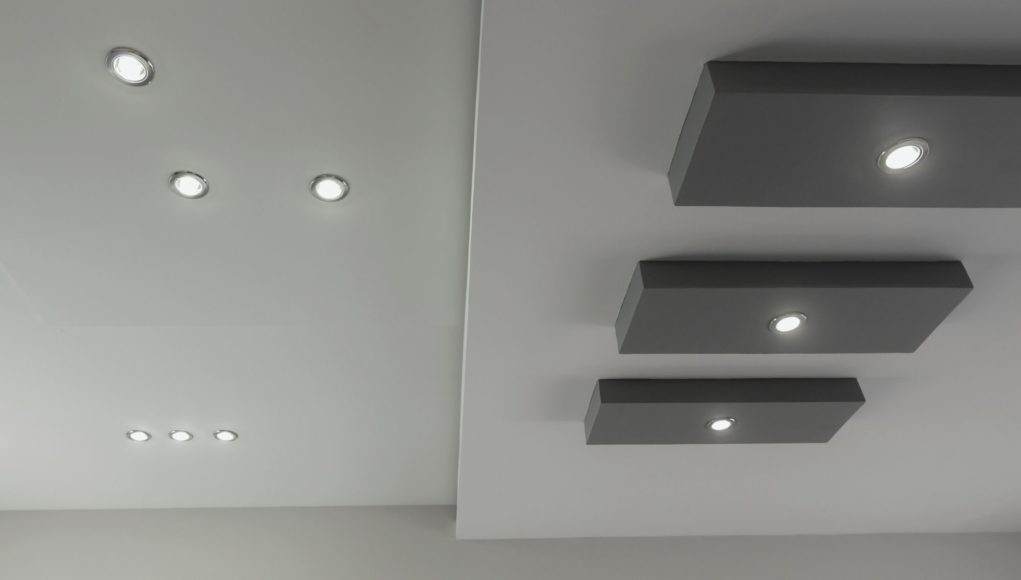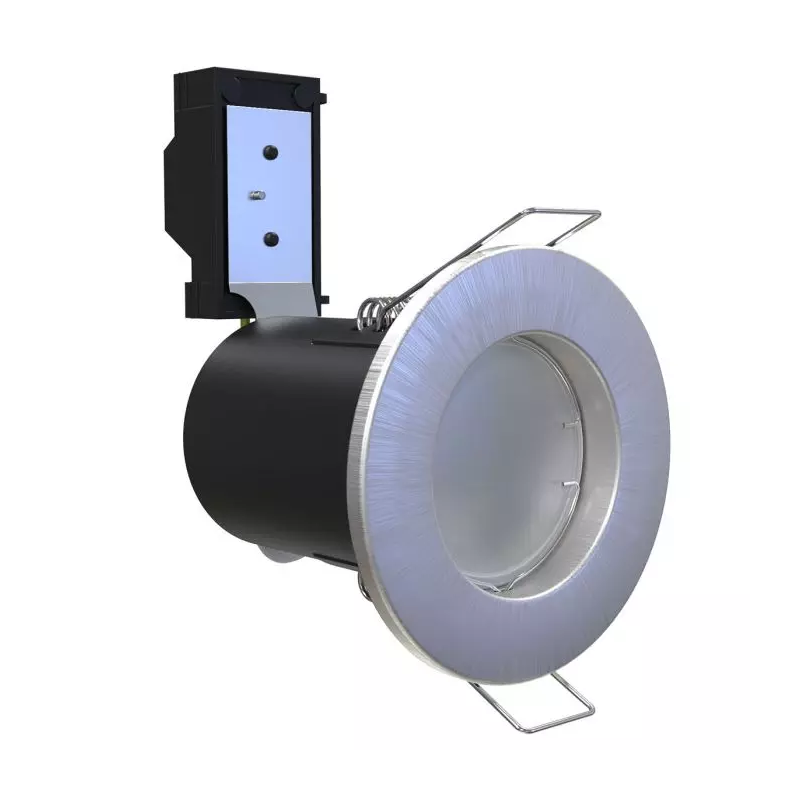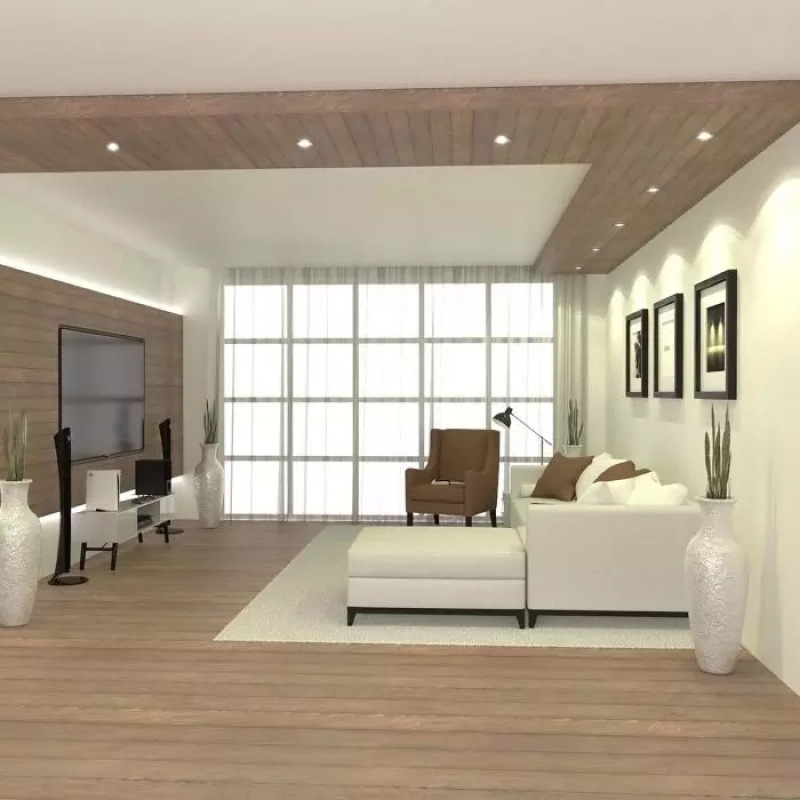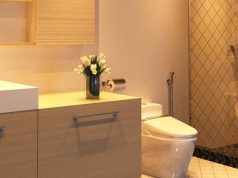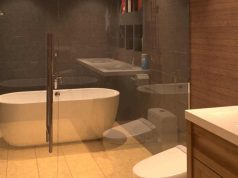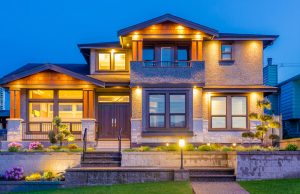Having a beautiful home is essential – but nothing is as crucial as having a safe home for your family and guests. Fire-rated LED downlights are a vital feature of any house for helping prevent the spread of fire. The best part is, you can add these safety features at a nominal fee without compromising the style and design of your home.
What Are LED Fire Rated Downlights?
Fire-rated downlights are a type of recessed light that restores the fire integrity of a ceiling. Once installed, they seal off the hole where you placed the lights. This helps slow down the spread of fire, giving you and the fire personnel more time to react—it ensures safety and less destruction of property in the end. When mounting recessed lights, you need to cut a hole in the ceiling. This hole becomes an access point for the fire to infiltrate the rest of your home. Similar to fire-rated ceilings and floorboards, fire rated downlights act as a natural fire barrier. Modern fire rated downlights are fitted with an intumescent pad. When the pad reaches a certain temperature, it swells — blocking the hole keeping the fire from spreading upwards into the ceiling and throughout the home. When the fire can’t get through the recessed hole, it finds another pathway. This delays the fire’s progress, giving you and your family more time to escape safely.
What’s The Science Behind Intumescent Materials?
Modern fire-rated downlights are fitted with an intumescent pad. When the pad is exposed to heat and reaches a certain temperature, the material swells, sealing the hole to block oxygen. No oxygen means no fire. The swollen pad also provides insulation from the heat. This combination of chemical reactions keeps the fire from spreading upwards into the ceiling and throughout the home. When the fire can’t get through the recessed hole, it finds another pathway. This delays the fire’s progress, giving you and your family more time to escape safely.
When the fixture is not pre-fitted with intumescent material, you can apply it manually. Intumescent materials come in various forms, including coatings, strips, and seals. Choose what can best seal the gaps between your light and ceiling. You can also seek the advice of professionals to get the correct information.
Different Classifications of Fire Rated Downlights
Fire-rated downlights are classified based on ratings. The most common are 30, 60, and 90 minutes. These ratings indicate the amount of time the fixture can withstand fire and smoke, as well as how long it takes to pass through it.
Manufacturers make sure that the lights are tested to maintain this standard. Fire-rated downlight tests follow the BS 476 (Part 22) methods for testing the fire resistance of non-load-bearing construction elements. The subject is exposed to a controlled fire environment in a furnace, where its integrity and insulation performance are observed and assessed.
To know which rating to get, identify the number of floors. Downlights rated between 30 and 60 minutes are sufficient for two- or three-story homes. Large buildings with multiple floors (like apartment complexes) might require downlights rated for 90 minutes or even more.
Another thing to consider is the type of ceiling you’re installing the light into. The fire-rated downlight’s rating should match the ceiling’s fire rating. For example, a downlight with a 30-minute rating should be used in a ceiling with a 30-minute rating, a 60-minute rating for 60 minutes, and a 90-minute rating for 90 minutes. Using a mismatched rating will compromise your ceiling’s fire integrity.
Why Do We Need Fire Rated Downlights?
Aside from providing safety, there are other great reasons to install fire-rated downlights.
- Safety – Safety is the most important reason for installing Fire Rated Downlights… “Fire Rated Downlights help to restore the integrity of your ceiling, slowing the spread of fire to floors above and allowing you and your family more time to escape safely should the worst happen.
- To Keep up with regulations – Building regulations change all the time. It is essential to make sure that when you’re changing or installing new downlights, you keep up with the rules. Ensure that you are using the correct downlights for the building/room where you plan to install them.
- Insurance – If you’re not using the correct lights, it could reflect as negligence on your part. If a fire did, unfortunately, occur, then they could invalidate your insurance and claim that you did not follow regulations.
- “Electrician said” – Listen to what your electricians say. If they tell you to install a specific type of downlight, do so. Electricians have regular updates on building regulations, and they know more than anyone what you need to make sure you’re safe. If you are unsure, you can always check with your local council for building regulations.
- Modern – Decor trends change quickly but this type of light is up to date! Keep your home looking modern by changing the colour/style of your downlights.
- Updated Technology – A lot of lights may look the same, but the way they work and the amount of energy they consume can be very different. Make sure you are at the cutting edge of technology by changing your downlights.
- New Building Requirement – Newer built properties may have different infrastructures that you need to take into account. Different styles of joists or new types of ceiling materials can massively impact the type of downlight you will have to use.
Building Regulations in Detail
Let’s review the important lighting regulations and certifications that your fire-rated downlights need to comply with.
UK Building Regulations
All electrical and installation work carried out in the UK must adhere to The Approved Document B of the UK Building Regulations, which covers the fire safety rules. The document tells you to keep the ceilings fire-resistant, ensure the recessed lights do not compromise fire integrity, and use the correct fire rating for the building.
BS 7671 – IET Wiring Regulations
This regulation covers the installation of fire-rated downlights, specifying that only qualified electricians can install the fixtures. Proper wiring and insulation are also needed to prevent overheating and reduce fire risks. Bathrooms and kitchens also need to have high IP-rated lights to maintain safety.
BS 476-21
This standard has detailed fire resistance test requirements for load-bearing elements in construction, including downlights. Compliance with this standard means that the fixture has undergone rigorous testing to ensure it has a fire resistance of 30, 60, 90, or even 120 minutes in some cases.
Certifications
Look for labels like BS EN 60598-2-2 or CE/UKCA certifications when buying fire-rated downlights. Lighting fixtures with these certification marks mean that they meet British Standards.
Why Fire Ratings Matter Beyond Legal Requirements
It is the responsibility of homeowners, landlords, and contractors to make sure that all lighting installations comply with UK Lighting regulations (OSHA Lighting regulations for those in the USA). Not following the set standards could have legal and financial repercussions, but even more so, it can compromise the fire integrity of your home or building.
Proper compliance with regulations has the potential to save lives and minimise property damage.
Types of Fire-Rated Downlights
So now you know why you need to switch to fire-rated downlights. But which one? You can organise the different types of downlights into three categories: Lamp Type, Fixing Method, and Style/Design.
Lamp Type
LED Downlights – Energy-efficient and long-lasting, making them the most cost-effective choice of downlights. There’s also a dimmable and smart integration option.
Halogen Downlights – Traditional, less efficient, and not as versatile as LED, although some have dimmable options.
CFL (Compact Fluorescent Lamp) Downlights – Has moderate energy efficiency, and lifespan is between LED and halogen lights.
Smart Downlights – Wi-Fi and Bluetooth-enabled with colour changing function and adjustable brightness that can be controlled via apps or smart home systems.
Fixing Method
Recessed Downlights (Fixed) – A light fixture installed flush with the ceiling, giving a clean, minimalist look.
Adjustable (Gimbal/Tilt) Downlights – Used for directional lighting, ideal for highlighting architectural features or art.
Surface-mounted downlights – These are mounted on the ceiling surface, so they’re more visible than recessed ones.
Style/Design
Fixed Downlights – Downlights whose beam direction cannot be adjusted.
Adjustable – The swivelling head component allows for beam adjustment.
Trimless Downlights – A plaster-in light, perfect if you’re looking for a discreet, modern aesthetic.
Colour-Changing Downlights – Typically LED or smart downlights; have RGB or RGBW options, suitable for mood lighting.
Installing Fire-Rated Downlights
When it comes to installation, fire rated downlights aren’t much different than traditional recessed lights. Installation is relatively easy since most downlights come with an installation sheet and guide. Be sure to cut holes accurately on the ceiling to ensure a snug and secure fit. You can install fire rated downlights in all areas of your house, but they’re most commonly found in living rooms, kitchens, and bathrooms (must be IP65 rated).
Comprehensive Installation Guide
Here’s a step-by-step downlight installation process:
- Locate and mark the ceiling joists and then mark the desired area where you want to install your downlights. You can use a stud finder to locate joists or simply knock on the ceiling. A solid, thumping sound means there’s a joist where you knocked.
- Also, locate pipes and wires using a detector to make sure there’s nothing in the way of your light.
- Measure the rear diameter (the part that will be inside your ceiling) of the downlight you’ve chosen. Make sure to select a downlight that will fit inside your ceiling space.
- Cut a hole using the measurement you got in your preferred area. It’s best to use a hole saw to cut through.
- Turn off the power from your circuit breaker and run a wire toward the spot where you’re installing the light.
- Connect the downlight to the wire. Make sure to follow the manufacturer’s instructions, as some downlights can have different ways to connect to the primary circuit. Get a qualified electrician to do all the wiring work.
- Hold the spring clips to the sides of the light and carefully insert the light into the ceiling hole.
- Push until you hear a clicking sound indicating the fixture is in place.
- Test if the light is working. Make sure to switch the circuit breaker back on.
Check out How to Install Fire-Rated Downlights for a more detailed version.
Common Installation Mistakes to Avoid
Let’s face it: not all light installations are perfect. A considerable percentage is far from ideal. Yet most of them could be done better by simply avoiding these common mistakes:
- Haphazard placement – Poorly placing fire-rated downlights without any positioning and alignment plan can result in uneven lighting creating eye strain and fatigue and bringing the whole aesthetic of the place down.
- Overloading circuits – Don’t overload your circuits with too many downlights. Doing so can cause flickering lights or worse electrical fires.
- Ignoring insulation requirements – Recessed downlights heat up (LED options only produce minimal heat). Prevent fire hazards by properly insulating your ceiling spaces.
- Using incorrect tools – Using the wrong tools can be a safety hazard during and after installation.
Fire-Rated Downlights and Thermal Insulation
Does the loft or gap above your ceiling have a layer of thermal insulation? If so, you may be wondering if you can cover fire-rated downlights with thermal insulation. It depends. Before doing anything, check if you can cover the downlights with insulation. If it’s okay, then go for it. But if it is not, then don’t. You might create some problems later on. Instead, what you can do is cut a hole in the insulation for each downlight, leaving at least 30mm of insulation free space around each. If you are still not satisfied with this and want to cover your downlights with insulation, use an IC Cap instead.
Design Ideas
Like other home lighting options, LED fire-rated downlights come in various styles and designs. You can choose one that compliments your current home decór or use them to upgrade your living space. Also, Fire-rated downlights are space-saving as they don’t take up a lot of ceiling room. They appear neat and clean no matter where you install them. Here are a few fire-rated downlight ideas that pair safety with style.
- Mood Setter – Aside from safety, one of the main reasons people choose fire rated downlights is to create a relaxing ambience in any room of the house. Downlights offer adequate lighting for activities such as homework, reading a book or cooking and some are also dimmable – great for when you’re entertaining or having a romantic dinner. GU10 dimmable downlights are a great option if you’re looking for versatility. These LED bulbs provide energy-efficient lighting that’s ideal for any situation and can be turned down to minimise glare on screens, such as televisions, computers or tablets, as well as phones.
- Splish Splash – When people consider lighting options for their homes, they often overlook the bathroom. IP65 shower fixed fire-rated downlights are an excellent choice for illuminating your bathroom space. These fixed fire rated downlights offer bright and functional lighting for shaving or applying make-up and performing your morning routine. They’re also dimmable when used with dimmable LED bulbs,, creating the perfect atmosphere for a relaxing bath or shower. Also, due to being IP65 rated, they are an ideal choice for installation near a water source, making them versatile in both bathrooms and kitchens. You can choose a polished chrome or satin nickel model to seamlessly match your other fixtures, like the taps, shower, and bathtub. Alternatively, you can install a white model for your ceiling, so it’s not very noticeable.
- Modern Aesthetic – Fire-rated downlights are surprisingly stylish, giving your home a modern, updated appearance. Unlike other recessed lights, you can mount most fire-rated downlights flush to the ceiling. That means there’s no gap between the ceiling and the outer casing. Make sure that you choose a casting that matches your interior. While the most popular options are white or chrome, they’re not your only option. Downlights come in different shapes, finishes and sizes. Also, you can purchase them individually or in packs to save you some money if you’re needing multiple. Many people use tiltable fire-rated downlights to illuminate a focal point, such as artwork on the walls, bookcases or curio cabinets.
Benefits of Using Fire-Rated Downlights
You can enjoy a lot of benefits from using fire-rated downlights. If you’re still not convinced, here are a few that might make you change your mind.
- Safety – The main point of having fire-rated downlights is to ensure safety. It is crucial to make sure you have a suitable downlight installed because the wrong downlight will not prevent the spread of fire but might be the one to ignite it.
- Insurance – As we mentioned earlier, if you do not follow the rules, your insurance may be void. If you have the proper downlights, you won’t have any problem with insurance, and you’ll have peace of mind.
- Style – A modern fire-rated downlight will guarantee safety and improve the whole aesthetic of a room.
- Energy Efficiency – You can save money on your energy bills by ensuring you’re using LED downlights. On average, you will consume 85% less energy compared to halogen lighting.
- Easy Installation – With the introduction of the loop in – loop out lights and quick connectors, it has never been easier to swap out old lighting.
How to Clean LED Downlights
Proper maintenance and cleaning can ensure that your fire-rated LED downlights last long and stay bright and energy-efficient.
- Cut the power from the circuit breaker.
- Gently twist or unscrew the downlight from the ceiling (if not possible, skip to the next step).
- Get a clean, damp microfibre cloth and wipe the fixture’s surface.
- Dry completely before reinstalling.
- Turn the power back on.
Troubleshooting Common Issues
Some common problems you’ll encounter with your fire-rated downlights are flickering, not turning on, or premature failure. All of which can typically be addressed by checking the light bulb: Is it loose? Does it need replacement? Did you get the correct wattage?
Perform visual and physical checks to determine what the problem is. If it turns out that the problem is more complex than you thought, get a qualified electrician to help you troubleshoot. You can’t DIY your way out of everything.
Lifespan Expectancy and Replacement
An LED light’s typical lifespan is around 50,000 hours. Of course, that’s not counting factors like failing to clean the fixture, or missing maintenance schedules. LEDs are cost-effective lighting choices since there’s fewer need for replacement. Just make sure not to neglect them.
Review Purchasing Considerations
Before you jump the gun and purchase your fire-rated downlights, consider first what we’ve discussed in this guide: what fire rating you need to get, the type of fire-rated downlight best suits your need, if you need one with a high IP rating, and what aesthetic you’re aiming for.
Once you have a clear picture of what fire-rated downlight you’re getting, you can now head over to your trusted supplier. Note: only get your fire-rated downlights from suppliers with proven track records. Make sure that their downlights are tested and certified by the proper regulatory boards.
Simple Lighting is one of UK’s top lighting suppliers, with a wide selection of fire-rated downlights you can choose from. We offer high-quality, compliant light fixtures at competitive prices. High IP rating, fixed, adjustable, GU10–you name it, Simple Lighting has it.
Now that you know what fire-rated downlights are, head on to our website and check them out! Not only are they stylish and visually appealing, but these lights can save a life. So, make sure to upgrade your lights with fire-rated downlights.
Frequently Asked Questions
Do I need fire-rated downlights in my home?
Yes. Building regulations often require them in buildings and homes.
Are fire-rated downlights compatible with LED bulbs?
Yes, most modern fire-rated downlights are LED-compatible, some are even integrated with LED. They’re efficient and have a long lifespan.
Do fire-rated downlights require a fire hood?
Usually not since fire-rated downlights are already built to meet fire safety standards. Only use fire hood if specified by the manufacturer.
Glossary of Terms
Intumescent
- (of a coating or sealant) swelling up when heated
CE/UKCA certification
- a CE marking indicates that a product has met health, safety, and environmental standards required within the European Economic Area (EEA)
- UKCA is a newer conformity assessment marking, demonstrating compliance with UK regulations
Flush
- completely level or even with another surface
Recessed
- set back into the ceiling or surface to which the fixture is fixed


